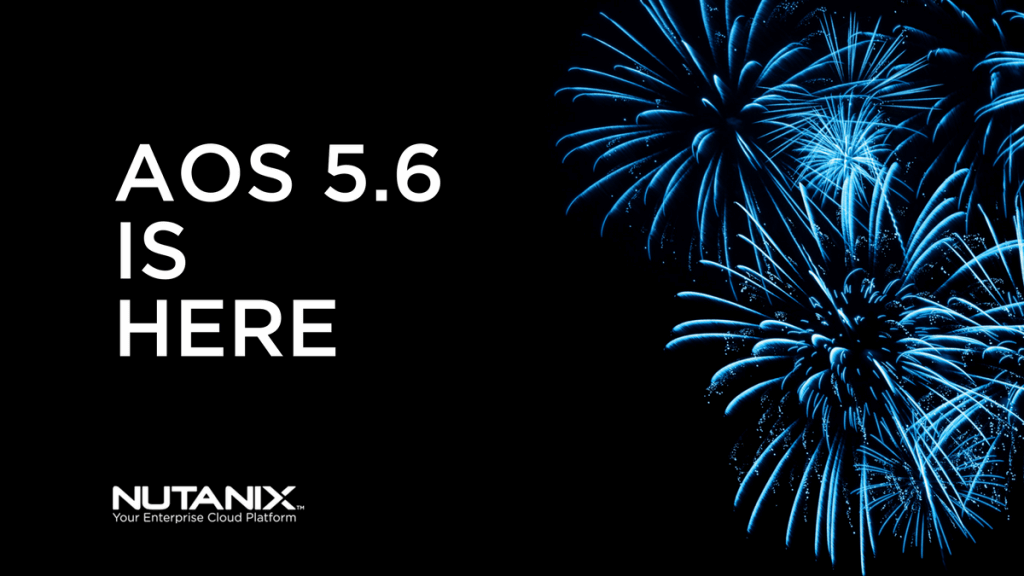Nutanix AOS 5.6 released

Nutanix has released version AOS 5.6 of their Acropolis Operating System (AOS). AOS 5.6 picks up where 5.5 left off, and makes Nutanix an increasingly persuasive choice for IT organisations to build their enterprise clouds with.
What’s new with AOS 5.6 ?
- Microsegmentation – Application-centric network security
- Greater performance for large databases with volume group load balancer on AHV
- Greater deployment flexibility with two-node clusters
- Delivering scale-out to Prism Central
- Delivering next generation v3 APIs
- Support up to 80TB per node
- Guest OS shutdown operations for AHV
- Erasure coding in-place overwrite
Microsegmentation – Application-centric network security
The first set of SDN security features are coming out of tech preview with the GA of microsegmentation in AHV. Customers can immediately take full advantage of a stateful distributed firewall in the form of microsegmentation, network automation, and service insertion/chaining as they are natively integrated to AHV and Prism Central. Most importantly, it is easier to improve security posture through granular application segmentation, VDI user isolation, quarantine, and much more. Nutanix “1-click” simplicity applies to policies that are created and enforced with no requirements on the underlying network. Allowing admins to manage policies without needing physical network configuration or deep application knowledge. Additionally, network functionality can be extended via service chaining capabilities that allow for Nutanix ecosystem partners to insert their own advanced capabilities to cover most customer needs.
Greater performance for large databases with volume group load balancer on AHV
When running large databases and high performance applications, application IO demands can be very high. The volume group load balancer allows Nutanix clusters to scale-up per application needs by leveraging the scale-out architecture of our distributed file system. Thus, application disk IO can get automatically spread out across multiple nodes in a Nutanix cluster leveraging multiple CVMs to deliver the required performance.
Greater deployment flexibility with two-node clusters
Remote office/branch office customers can now deploy clusters in 1-node and 2-node configurations. This allows remote sites to still take advantage of Nutanix and better scale the deployments to their needs. Now with the support of Prism Central 1-click scale-out feature, customers can benefit from simple remote management of many sites and thousands of VMs.
Delivering scale-out to Prism Central
In AOS 5.6 we are announcing the scale-out support for PC. With the this support, multiple instances of PC form a distributed control plane. Thus, customers having mid to large Nutanix clusters are now able to benefit from higher PC resiliency and leverage the distributed cluster resource. More importantly, they are able to benefit from the simplicity of 1-click scale-out option of PC.
Delivering next generation v3 APIs
AOS 5.6 brings forth Virtual Infrastructure Management capabilities via the RESTful V3 APIs. These APIs are built on an intentful model and are limited to Prism Central. They will allow customers to deliver a self service portal functionality to their IT organizations along with many other features such as microsegmentation.
Support up to 80TB per node
In this release, we are announcing the support for 80TB of capacity per single node. This feature delivers more capacity and space consolidation for capacity heavy workloads. Now customers can expand the existing cluster’s capacity with 80TB nodes. This will be a great solution for a backup use cases. For example, ROBO locations that need local backup can leverage the 80TB nodes. Please refer to our qualified platform list for more information.
Guest OS shutdown operations for AHV
Modern applications are complex. To help make administration easier, AHV has been enhanced with guest scripting for automation of power state operations. The new option allows customers to execute user defined shutdown scripts to reboot/shutdown the guest OSs manually via Prism or incorporate it into existing automation via our APIs.
Erasure coding in-place overwrite
Erasure coding can have an impact on the storage overhead and background operations. The new Nutanix EC-X now supports in-place overwrites or updates. By computing updated parity bits inline, we are able to avoid follow up background operations, and reduce the amount of storage overhead (garbage data), thereby improving EC-X efficiency in a system. Customers that are using EC-X will immediately benefit from this feature.
What’s new with AFS 3.0?
- NFS protocol support
- AFS adds incremental file level backup support
- Active-Active deployments
- File auditing
NFS protocol support
The wait is over, with this release AFS is supporting the NFS v4 protocol. With support for both NFS and SMB protocols, AFS can address a wide range of use cases including Linux support, and Windows home directories, user profiles and department shares. AFS supports separate SMB and NFS shares/exports on the same file server. For more details on NFS v4 refer to this blog.
AFS adds incremental file Level backup support
AOS 5.6 incorporates Change File Tracking (CFT) to allow efficient backups. Nutanix has exposed REST APIs to enable these backups. CFT based backups are more efficient, eliminating the need to traverse the full data sets over and over again. Therefore, customers can leverage the simplicity and efficiency of CFT and enjoy integrated backup solutions for AFS. We are actively working with partners to build support for these APIs.
Active-Active deployments
With the Active-Active deployments geographically dispersed teams will benefit from fast, local access to project file replicas maintained in real-time across multi-site AFS clusters. Also, this would be able to handle Sync profiles and home directories across locations in real-time to ensure that VDI instances have fast local access to user data.
Nutanix has a partnership with Peer Software, wherein we will integrate with their PeerLink product. Each site collaborating on a project (or at the two sites in case of VDI load balancing) will have an independent AFS namespace. Anytime, there is a relevant change within an AFS namespace, the PeerLink software will be notified about the change. PeerLink will then replicate this change to all the “peer” AFS namespace(s), including file locks, keeping the namespaces in sync. This will allow for bi-directional synchronisation between two sites, or multi-site synchronisation for collaboration of projects.
File auditing
We have exposed REST APIs to provide audit capabilities such as maintaining audit logs of all access/modification to AFS. File Auditing can be done through an external syslog server, and we are vigorously working with partners to deliver powerful auditing solutions.
For more information on AFS partner ecosystem, please refer to this blog.
This was a short and sweet version of the Nutanix AOS 5.6 release. My favorite one is AHV security enhancement by supporting microsegmentation. There are additional features that are not covered in this blog post. You can get the complete release notes and download the upgrade bundles from my.nutanix.com. Please remember that your feedback is crucial to us for developing features that are efficient, simple, and innovative.
This blog includes forward-looking statements, including but not limited to our plans to integrate our products with our partner’s products. These forward-looking statements are not historical facts, and instead are based on our current expectations, estimates, opinions and beliefs. The accuracy of such forward-looking statements depends upon future events, and involves risks, uncertainties and other factors beyond our control that may cause these statements to be inaccurate and cause our actual results, performance or achievements to differ materially and adversely from those anticipated or implied by such statements, including, among others: the failure to integrate our products with our partner’s products and the possibility that we may not receive anticipated results from forming such partnerships; the introduction, or acceleration of adoption of, competing solutions, including public cloud infrastructure; a shift in industry or competitive dynamics or customer demand; and other risks detailed in our Form 10-Q for the fiscal quarter ended January 31, 2018, filed with the Securities and Exchange Commission. These forward-looking statements speak only as of the date of this presentation and, except as required by law, we assume no obligation to update forward-looking statements to reflect actual results or subsequent events or circumstances.
Resources for AOS 5.6 ( may require a valid my.nutanix.com account):
